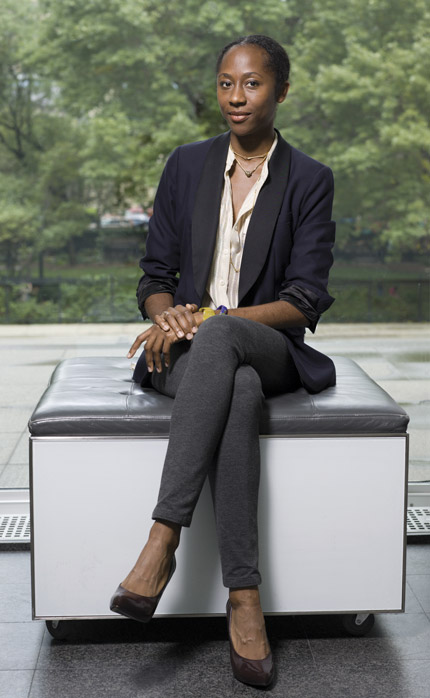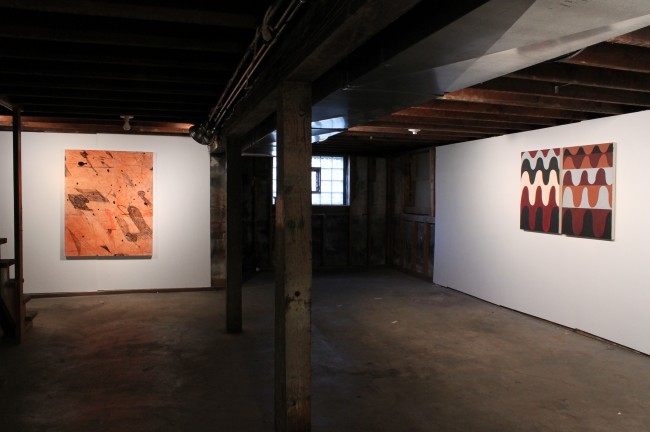The Museum of Contemporary Art has got a lot going on for it lately with some brand new faces, one of which might just turn the institution on its ear. Naomi Beckwith’s meteoric rise as a curator brings her to the MCA from the Studio Museum in Harlem, NY. She greets you with a slightly raspy, silkysmooth, ready-for-radio voice and an easy, genuine laugh.
PATRICK G. PUTZE: What’s your favorite show of the season?
NAOMI BECKWITH: I was really hyped about what was going on around the West Loop. The Tony Wight Gallery has Barbara Kasten showing. Angel Otero and Nathaniel Donnett are at the Kavi Gupta Gallery and then there’s Jason Lazarus at the Andrew Rafacz Gallery. Instead of talking about a favorite show, I love to talk about the fact that I’m seeing a really good variety of shows. Throughout the summer, there’s been a really good breadth of art here in Chicago.
PGP: Have you heard much criticism of the MCA? I hear some in Chicago are divided over the architecture of the building itself.
NB: The MCA is Mies Van Der Rohe-ish boxes within a box, right? Maybe people think it doesn’t fit in because it doesn’t look like one type of Chicago building, but a mélange of several things that are very, very Chicago. There’s also the Frank Lloyd Wright homage with the Prairie Style evident throughout the building, mostly in the leaf-shaped staircase with its skylight that has the veining of a leaf.
PGP: Not to mention the koi pond at the foot.
NB: That’s one of my favorite things! The Rookery also inspires the MCA with this great staircase that goes up and then a lot of space on that ground floor that goes all the way up to the ceiling.
PGP: It opens up immediately.
NB: Exactly! The museum is definitely designed so that when you walk up those stairs, you come into the space and there you have it: art!
PGP: So it’s readily accessible? 
NB: Absolutely. This building is an
interesting walk through Chicago’s architectural history. At the same time, I’ll be the first to admit, it’s quirky, and so that’s my challenge as a curator. I’m constantly working to make the architecture come alive but also disappear.
PGP: How does the MCA in its current state compare to your experience of the old one?
NB: Well, you have to realize my old experiences at the MCA are really only parties! [laughing] I came to the opening party in 1996. The MCA hosted the Summer Solstice Party and was open for 24 hours.
PGP: The longest day gets the longest party?
NB: Yeah…absolutely! You know, people after my own heart [laughing]. They threw this slightly Pagan ritual that I think attracted people in a way that made them unintimidated by what they might see inside. I also remember visiting the old building, especially when I was in school at Northwestern. I remember seeing Kerry James Marshall and it changed my life, because, finally, there was this painting practice that encompassed my own memories, you know? It validated my cultural history. Of course, coming back as part of the team is a whole different experience. I had never seen any of these back offices.
PGP: So it’s an “ah ha!” moment – telling yourself, “So that’s what goes on back there!”
NB: Absolutely! The one thing I tried to do when I interned [at other institutions] was to ask to see the guts of the place. I think my biggest hope is to make sure that people feel comfortable here. The other nicety is that I never really interacted with the theater side of the programming before I moved away from Chicago. It’s so great to come back to get involved with that.
PGP: Jimmy Robert is going to be your curatorial debut. Isn’t that comparable to what’s about to happen with the Eiko and Koma’s Naked performances?
NB: There’s something really incredibly magical about Eiko and Koma. It was the first time I had walked into those galleries and been transported wholly somewhere else. That opened my eyes to the real possibility of space that could be theatrical, but also house the art objects. It becomes this beautiful space that gets expanded into mise en scene.
PGP: Does Robert’s work touch on interactions with the audience?
NB: That is absolutely one of the reasons why I chose him. He’s done performances where he wouldn’t look at, or even acknowledge the audience. The challenge is: how do you work in a space and not look at anybody around you? He had to keep turning away. The Q&A audience begins to understand that he’s willfully ignoring them. It’s great because the people in the space experience something other than still objects. With Eiko and Koma, we’ve been very lucky that we’re able to bring them back several times. We’ll see what happens with Robert, but definitely at least one performance will happen in the galleries.
PGP: What do you think are some strengths of the Chicago art community?
NB: The first thing that’s great is our amazing, world-renowned art schools. You already have this army of well-trained artists and thinkers in the city, and a lot of them stay here. One thing I think that really sets Chicago apart from everywhere else I’ve been is the preponderance of alternative galleries – and curators aren’t starting them, the artists start them. They foster all kinds of projects and engage in never-ending conversations within communities.
PGP: Do you see any weaknesses in the Chicago art community?
NB: I wouldn’t call it a weakness, but I would love to see people thinking about the next stage with all of these alternative spaces. I would love to facilitate a conversation with artists about how one begins to manage one’s career and the structures one builds around those careers, like these experimental spaces. Or even, if you’re going to shut it down – which I’m absolutely supportive of as well – how do you archive it? You should always leave a very good record and be conscious of [maintaining that archive] when you’re doing so well. This is very important for these artists with these spaces and I certainly hope that continues.







